USC Village: an Architectural Identity Crisis

I will admit, I didn’t hate it as much as I thought I was going to. USC Village, the University of Southern California’s massive new student housing and retail complex replaces an unobtrusive—if uninspired—low-slung open-air mall surrounded by surface parking with a five story red brick gothic-pastiche open-air mall with underground parking. On the surface, the buildings are little more than mediocre historical revival, but those faux-gothic facades represent USC’s desperation to be seen as a “serious” university, and a disconnect with their own history.
In the interest of full disclosure, I should note that I have a very personal connection to USC. I spent seven years there as a student, earning Bachelor’s and Master’s degrees from the School of Architecture. All in all, I’m very happy with the experience I had there as a student (despite a student debt load that I didn’t fully comprehend until it came time to pay it back in the middle of the Great Recession, but that has more to do with timing than the school). If you love something, you tell the truth about it. I love USC, but they suck at choosing building designs.
Another disclosure: I think that designing buildings to parrot historical styles is lazy and dishonest. But I also know that mine is not the only opinion that matters, and beauty and style are subjective. All architecture references history in some way, intentional or not. There is no truly “new” style.
Setting aside the question of style for a moment, there are a few things that are not horrible about USC Village. It improves pedestrian connections across Jefferson Boulevard, and it ever so slightly opens up the campus—which had been veering toward a fortress mentality in recent years—to the surrounding neighborhood. It replaces surface parking areas with expansive new lawns (though the “no tailgating” signs strewn throughout the area on a Saturday morning prior to a preseason LA Rams game at the nearby Coliseum, and massive steel gates at every entrance that could seal off the entire complex at a moment’s notice are stark reminders that this is still very much Private Property). Most importantly, USC Village provides a major influx of much needed student housing. If USC Village had been around when I was a student, I probably would have been thrilled with the easy access to Trader Joe’s and Target.
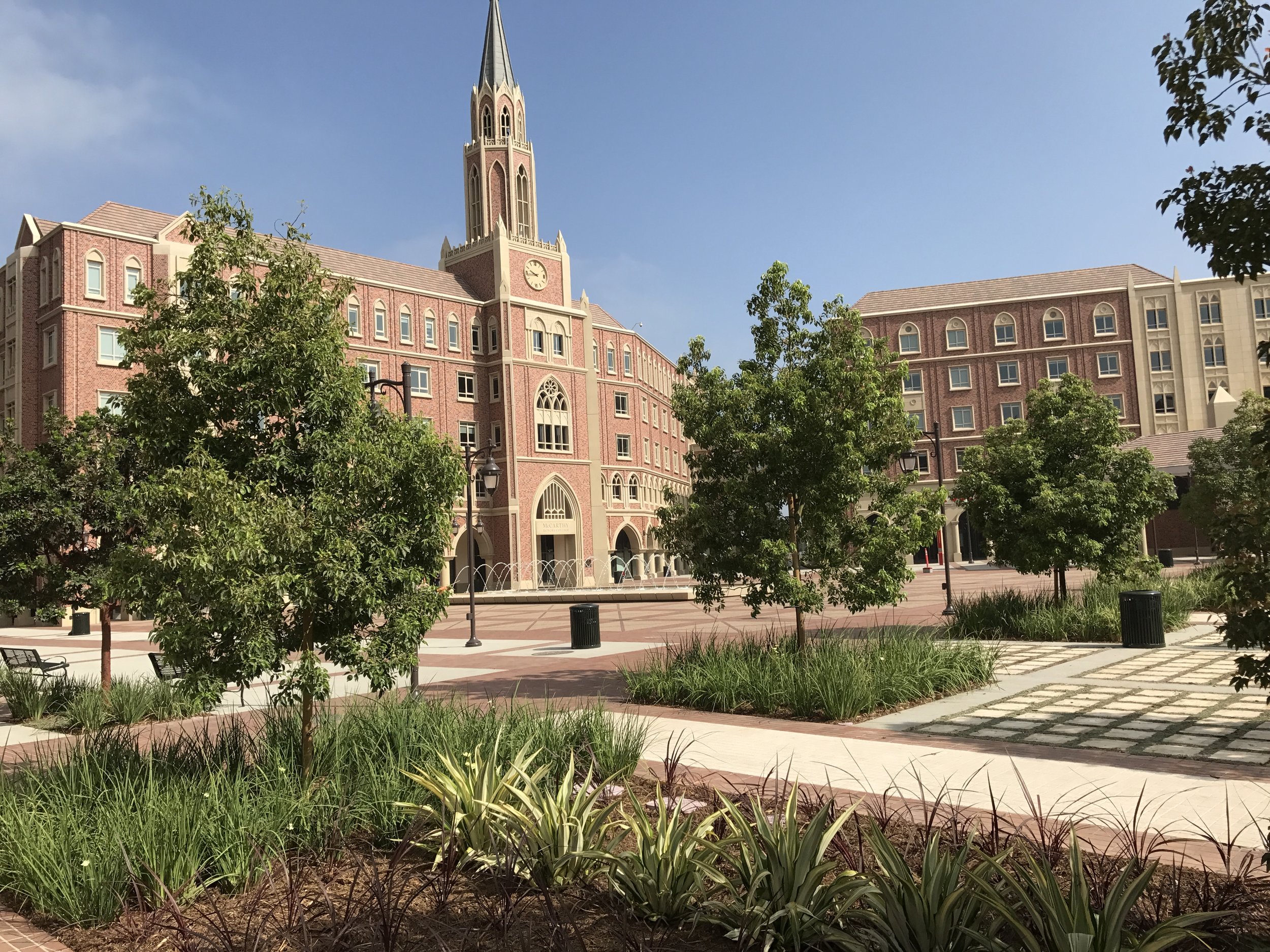
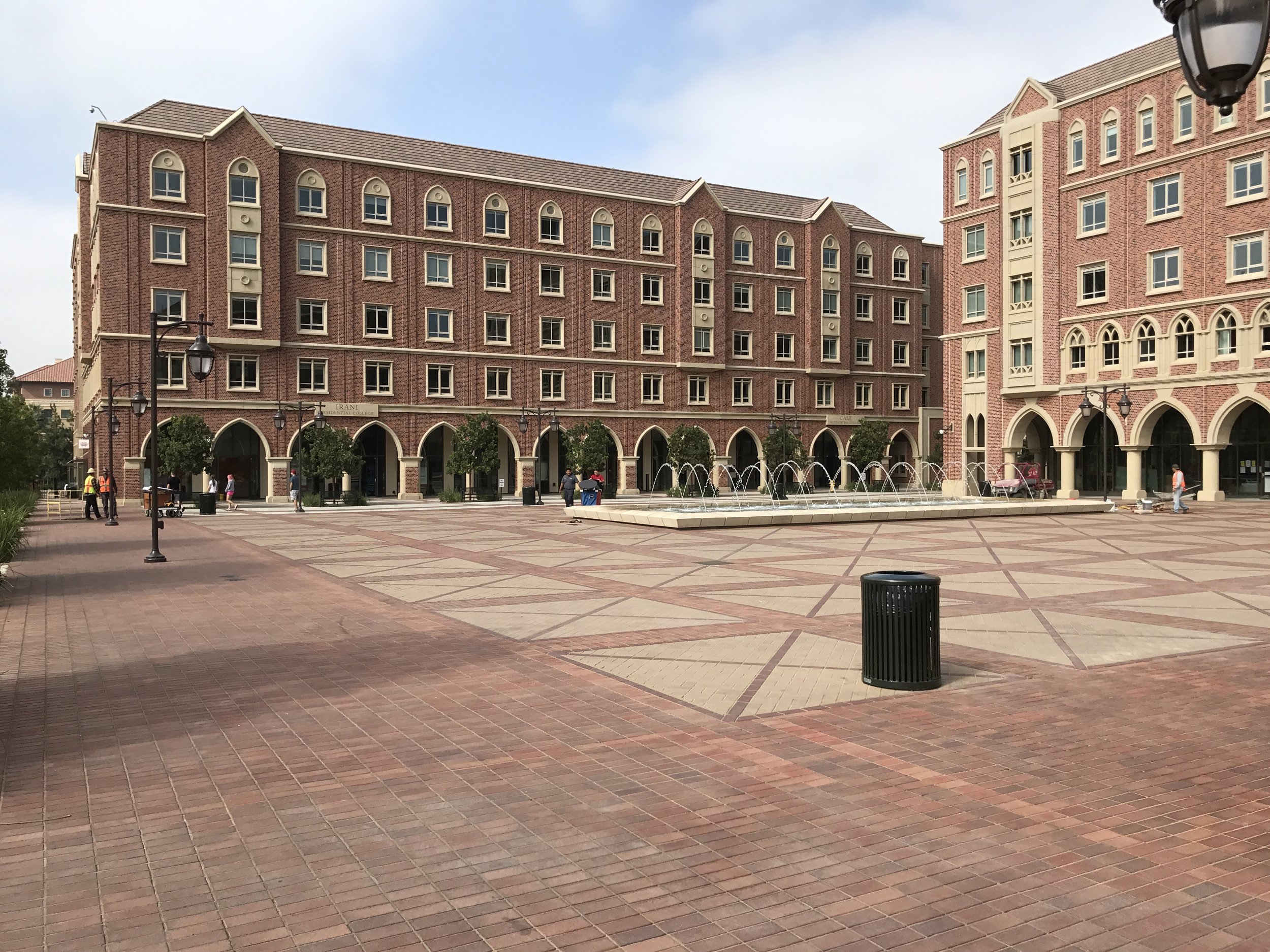

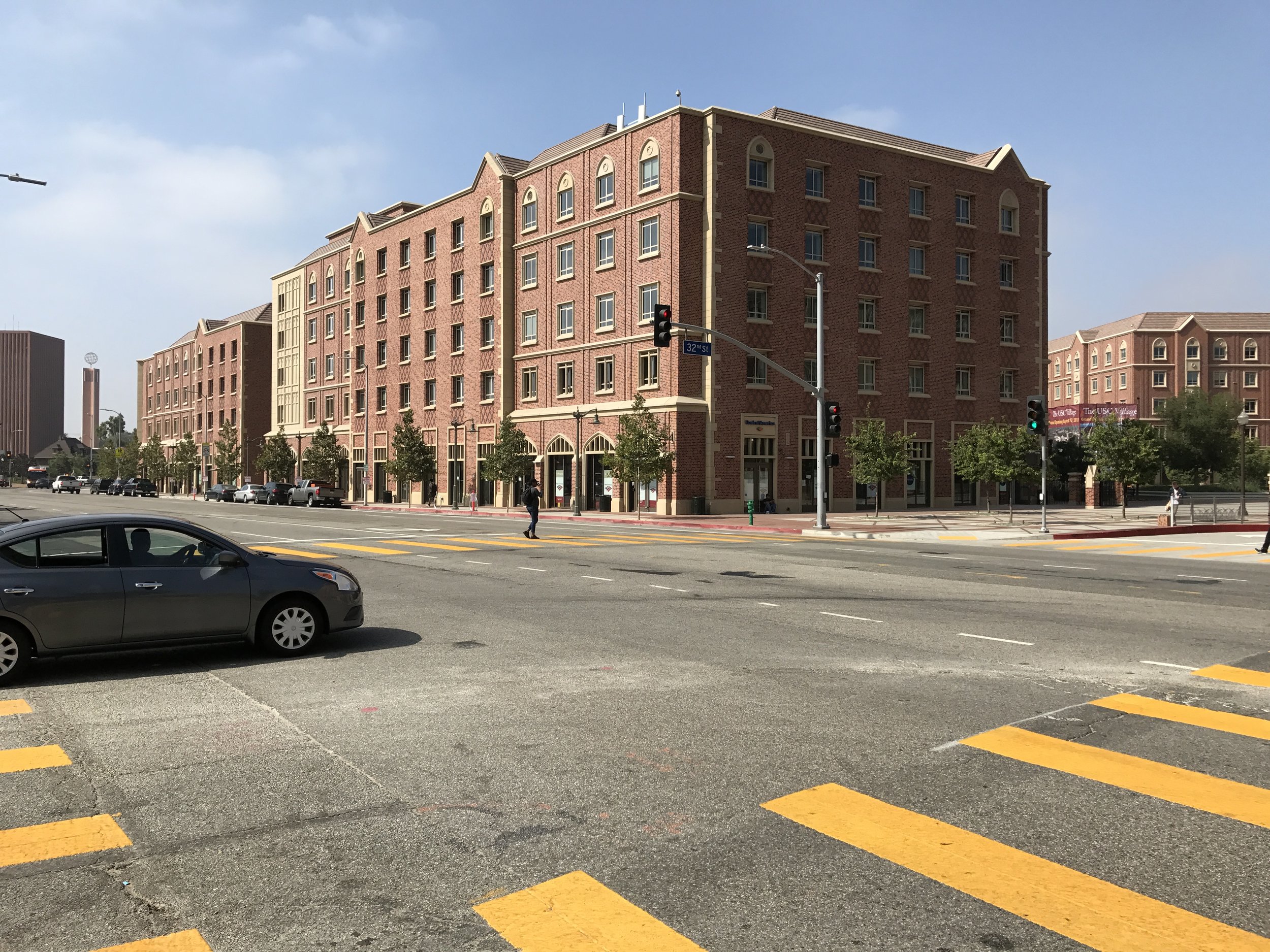

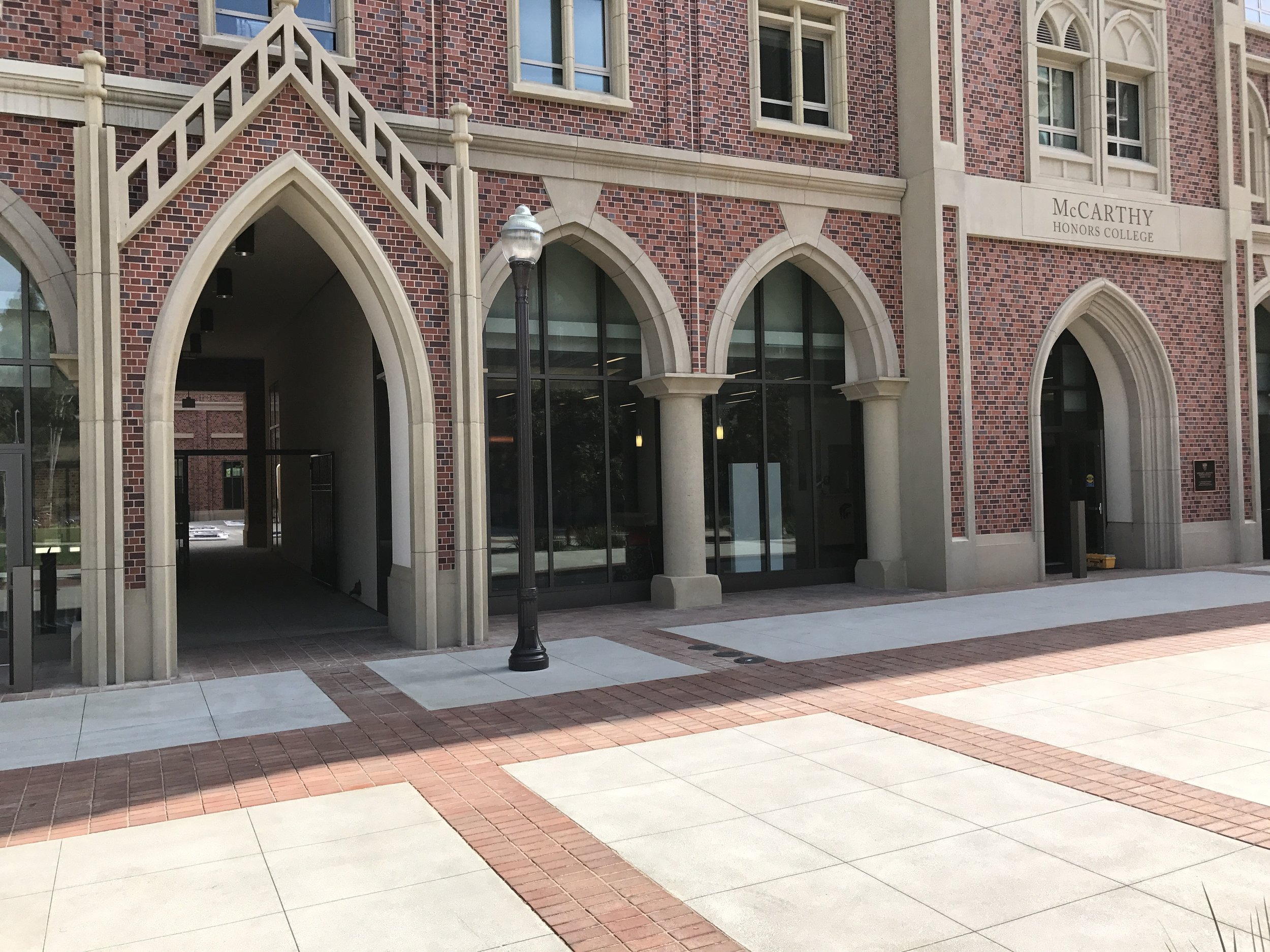
But back to the issue of that faux-gothic style. In the past few years, USC has been on something of a building spree with a slew of new buildings, bearing the names of high-dollar donors, popping up all around campus. And almost all of them have been in this strange red-brick hybrid version of so-called “Collegiate Gothic” (the one exception being the recent building for the School of Cinematic Arts, which was built in a completely incongruous neo-Tuscan style, as demanded and designed—at least according to rumor—by Star Wars creator and USC mega-donor George Lucas). As much as I may not like it, I can understand why a university (USC or otherwise) might choose to build new buildings that emulate a historic style. Universities tend to be places steeped in tradition, lore, and shared history. And buildings, for better or worse, are symbols.
The problem with this new rash of faux-gothic buildings at USC is that they have nothing to do with the university’s actual history. USC has actual historical buildings, and a relatively coherent historic style that is not at all “gothic.” Someone once described USC’s institutional style to me as “Italian Romanesque.” Whether or not the “Italian” part of that descriptor is necessary, it’s an apt label used to refer to many of the university’s most historic buildings, including the Administration Building (better known for being the location of Bovard Auditorium), the Student Union, and Mudd Hall. These buildings are all characterized by curved arches (in contrast to the pointed arches of the gothic style), and bulky, massive forms (as opposed to the lighter and more open forms of gothic architecture). Even some of the more recent buildings like the mid-century Von KleinSmid Center (or VKC) and the new Campus Center adapted the curved Romanesque arches into their more contemporary designs.



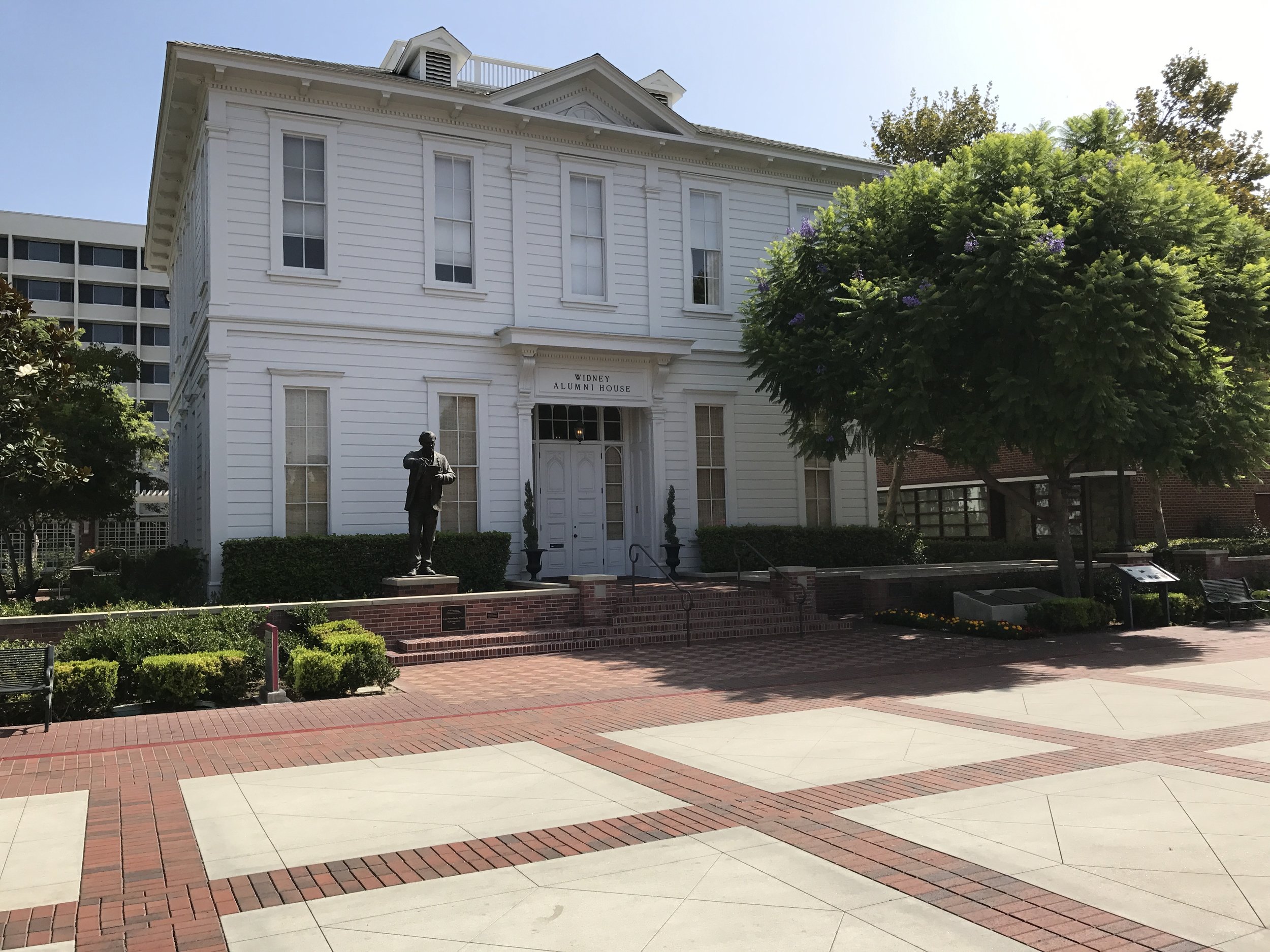
So the problem with USC Village is not that it looks like it was designed by a historicist architect who failed Architecture History class (though it does), it’s that USC thinks this gothic-ish style will help the university to be seen as a higher caliber institution. But it takes more than fake facades to change a school’s reputation. For decades USC has been doing the hard work of increasing academic rigor, becoming more selective in admissions, and aggressively recruiting high-caliber faculty. And the results of these efforts have been borne out in USC’s steady climb up university rankings lists (whether those lists are an accurate reflection of quality is another story). USC has reason enough to be proud of itself without copying someone else's homework.
The university’s dedicated website for USC Village describes the complex as “in the Oxford model of residential colleges.” Apparently they thought following the “Oxford model” also required hack reproductions of Oxford architecture, slathered in an over-generous helping of USC's "signature" red brick. After all the work USC has done to improve its reputation, this obsession with an incongruous and anachronistic architectural style reveals that the university still has a chip on its shoulder. It confirms all the worst stereotypes of the “University of Spoiled Children” or the “University of Second Choice” that they worked so hard to shake.
Were parking garages a common typology in the gothic era?
According to the former Dean of the USC School of Architecture, Qingyun Ma, this stylistic obsession has been wildly successful in USC President C.L. Max Nikias’s fundraising efforts, despite protests from architecture faculty. But as a USC alumnus, I’m wildly disappointed. As Kate Wagner, creator of the satirical blog McMansion Hell, once wrote, “To see something only for its superficial attributes or financial potential and execute it carelessly is the most ‘Mc’ thing anyone can do.” USC Village is the McMansion of collegiate architecture (McUniversity?), right down to the oversized and carelessly placed garage. Rather than drawing from USC’s existing historical context, USC Village, and all the other new “Collegiate Gothic” buildings, are “performing” the role of university—expending more effort on erecting a facade of what a university should look like, rather than considering what the university and the university experience should actually be.
But I guess this should come as no surprise. One tradition that USC Village is unlikely to disrupt is USC’s history of literally performing the role of other universities in countless movies and TV series.
![people[PLACES]spaces](http://images.squarespace-cdn.com/content/v1/576721b9c534a524caa154f1/1468892964341-A2P4OC3DSF0Q7HXIUYI7/Logo+%281%29.jpg)





